Welcome back to our green living room paint adventure! If you loved Part 1 of this series, you know how transformative a green wall can be—bringing life, warmth, and personality to any space. In Part 2, we’re diving into 10 more stunning green shades that range from soft, understated hues to rich, moody tones perfect for creating depth and drama in your living room.
If you missed it, check out Part 1 here for the first 10 shades. Together, Parts 1 and 2 give you a complete toolkit for choosing the perfect green for your home.
In this post, we’ll cover:
- How to pick the right green for your living room—from light and airy to deep and cozy, plus tips on undertones and lighting.
- How to decorate with green walls—including furniture, textiles, and accent ideas to make your green shine.
- In-depth color descriptions and styling guidance for 10 additional gorgeous greens, so you can imagine them in your own space before committing.
Whether you’re a green enthusiast or just starting to explore, this post will help you find the shade that transforms your living room into a space you’ll love coming home to.
How to Pick the Right Green for Your Living Room
Choosing the perfect green for your living room might feel overwhelming at first—there are so many shades, undertones, and moods to consider. But once you break it down, it becomes much easier to find a green that truly transforms your space.
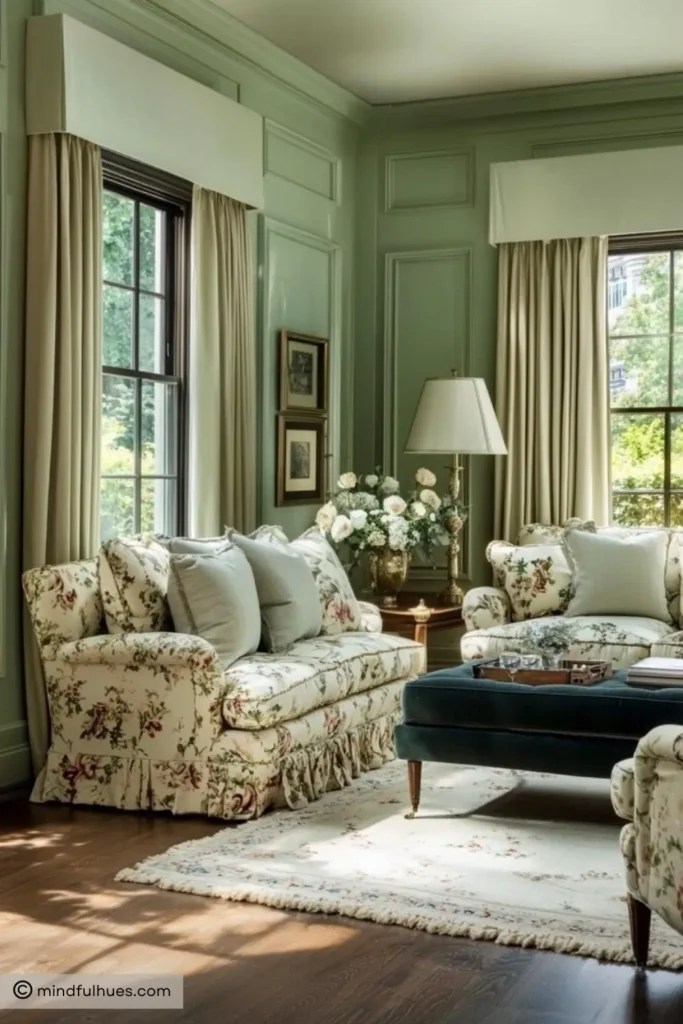
1. Light vs. Dark Greens
Think about the atmosphere you want to create. Lighter greens, like soft sages or airy olives, can make a room feel bright, open, and fresh. They’re perfect for small spaces or rooms that don’t get much natural light. On the other hand, darker greens, like deep forest or hunter shades, create a cozy, intimate vibe. They’re ideal for larger living rooms or areas where you want a sense of drama and sophistication.
2. Understand Undertones
Not all greens are created equal. Some lean warm, with yellow or olive hints, while others lean cool, with blue or gray undertones. Warm greens pair beautifully with wood tones, terracotta, and gold accents, while cool greens work well with crisp whites, grays, and modern metallics. Considering the undertone helps you coordinate your walls with furniture, flooring, and décor without clashes.
3. Consider Room Function
Think about how you use your living room. Energetic greens—brighter or slightly bolder shades—can make social areas feel lively and welcoming, great for family rooms or entertaining spaces. Muted or soft greens create a calm, restorative environment, perfect for reading corners or cozy lounge areas where relaxation is the goal.
4. Factor in Seasonal & Style Considerations
Green is wonderfully versatile, but your preferred style matters. A modern or Scandinavian living room might lean toward soft, muted greens with clean lines. Eclectic or bohemian spaces can handle playful, vibrant greens. And traditional interiors often shine with deeper, classic greens that add elegance and warmth. Also, consider how the color will feel throughout the seasons—a lighter green can feel fresh in summer, while deeper shades create warmth and intimacy in winter.
5. Test Swatches in Different Light
No matter how much you love a swatch online or in a paint chip, always test it on your walls. Paint small sections and watch how the green changes with morning, afternoon, and evening light. Natural light, artificial light, and even shadows from furniture can make a huge difference in how the color appears.
How to Decorate with Green Walls
Painting your living room green is just the first step—how you decorate around it can make all the difference. Green is surprisingly versatile, but pairing it thoughtfully with furniture, textures, and accents will bring your space to life.
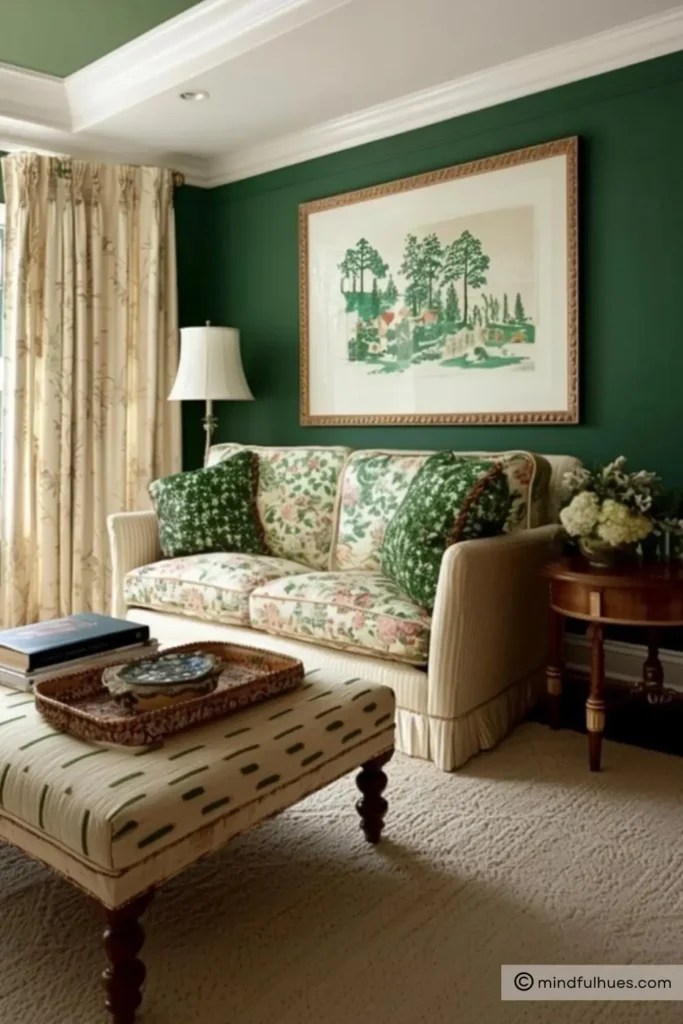
1. Layer Textures for Depth
Green walls act as a rich backdrop, so layering different textures helps the room feel dynamic and cozy. Think linen or cotton curtains, velvet cushions, wool throws, or even woven rugs. Natural textures like rattan, jute, or wood complement green beautifully, bringing in an organic, grounded vibe.
2. Complementary Colors
Consider the colors you’ll pair with your green walls. Whites, creams, and soft neutrals brighten the space and create contrast. Earth tones—like terracotta, ochre, or warm browns—enhance green’s natural, calming quality. For a modern twist, black or charcoal accents in furniture, picture frames, or lighting add sophistication and visual interest.
3. Furniture Placement & Style
Green pairs with almost every style, but think about scale and proportion. A statement sofa in a neutral or complementary tone can anchor the room. If you’ve chosen a bold or dark green, lighter furniture balances the intensity. Mixing old and new pieces—like a vintage armchair with a modern coffee table—also adds depth and personality.
4. Use Green as a Statement or a Backdrop
Decide whether your green walls will make a statement or act as a calming backdrop. Deep, rich greens are perfect for accent walls or cozy corners. Softer, muted greens work beautifully when covering all walls, letting furniture, artwork, and décor shine.
5. Lighting Matters
The right lighting can transform green paint. Warm light bulbs enhance warmer greens, while cooler bulbs complement sage or gray-leaning shades. Use a combination of ambient lighting (overhead), task lighting (lamps), and accent lighting (sconces or candles) to bring out the green’s depth at different times of day.
6. Incorporate Nature
Green walls are a natural invitation for plants and greenery. From potted palms to trailing vines, living plants echo your walls’ color, add life, and make the room feel fresh and vibrant. Even faux plants or floral artwork can reinforce this natural, harmonious vibe.
Decorating with green walls is all about balance: layering textures, mixing colors, and using furniture and lighting thoughtfully. Done right, green doesn’t just paint a wall—it transforms your living room into a welcoming, stylish, and inviting space.
10 Gorgeous Green Paint Colors for Living Rooms
1. Verdigris – Edward Bulmer Paint
If you’re looking for a green that feels timeless and full of character, Verdigris by Edward Bulmer is a stunning choice. It’s a rich, blue-leaning green that evokes the patina of aged copper—sophisticated, moody, and perfect for creating depth in a living room.

Image Credit: edwardbulmerpaint 📷 @paul_whitbread_photo
Why it works in living rooms:
Verdigris is ideal for cozy, intimate spaces or accent walls where you want to make a statement without feeling overpowering. Its subtle blue undertones give it a calming effect, while the richness adds a sense of drama and elegance.
Styling tips:
- Pair with brass or gold accents like light fixtures, mirror frames, or side tables to complement its vintage vibe.
- Works beautifully with dark wood furniture or velvet upholstery for a luxurious feel.
- Add natural textures—linen cushions, wool throws, or woven rugs—to soften the depth and keep the room inviting.
2. Sir Lutyens Sage – Little Greene Paint Company
For a soft, understated green with a touch of sophistication, Sir Lutyens Sage is a fantastic option. It’s a muted, slightly warm sage that feels elegant and versatile, making it ideal if you want a calm, welcoming living room.
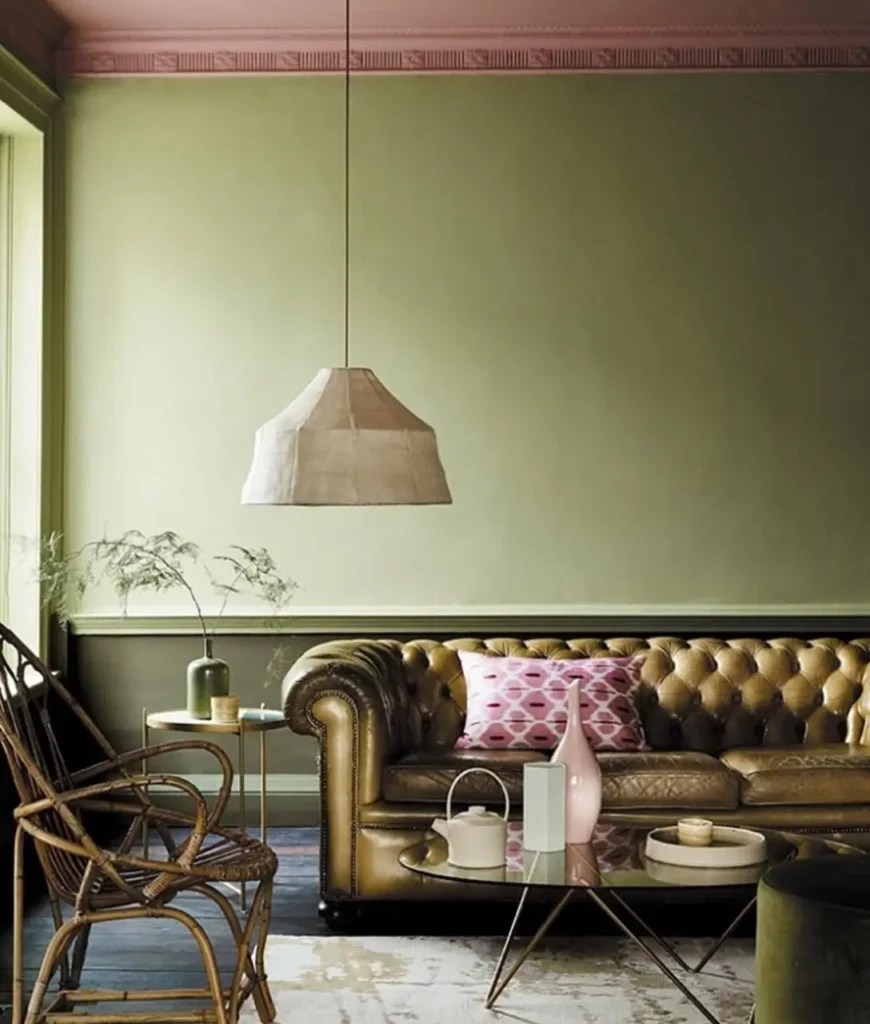
Image Credit: Little Greene
Why it works in living rooms:
Sir Lutyens Sage is perfect for creating a tranquil, airy environment. It’s a shade that works well across both modern and traditional interiors, adapting easily to different furniture and décor styles. Because it’s muted, it also makes the room feel spacious and light.
Styling tips:
- Pair with light neutrals like cream or soft gray for a serene, layered look.
- Adds a natural, organic feel when combined with wood furniture, plants, or woven textures.
- For subtle contrast, bring in warm metallic accents—think brass lamp bases or gold picture frames.
3. Ashwood Moss – Benjamin Moore
If you’re drawn to earthy, grounded greens, Ashwood Moss by Benjamin Moore is a perfect pick. It’s a mid-tone green with subtle mossy undertones, evoking the calm of a forest floor and bringing a natural, restorative feel to your living room.
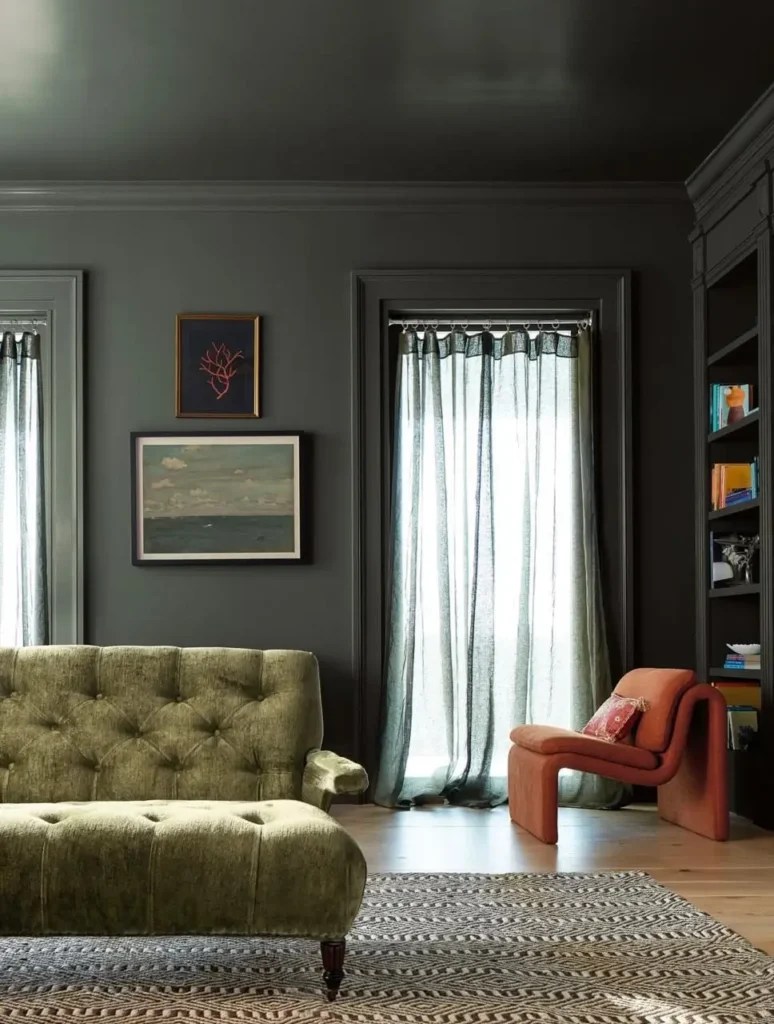
Image Credit: Benjamin Moore
Why it works in living rooms:
Ashwood Moss is ideal for creating a cozy, nature-inspired space. It works beautifully in living rooms where you want warmth and tranquility without overwhelming the room. Its versatility allows it to pair with both traditional and contemporary interiors.
Styling tips:
- Combine with leather or wood furniture to enhance the earthy, organic vibe.
- Layer in textured fabrics like wool throws, linen cushions, or jute rugs to add warmth.
- Accent with terracotta, ochre, or soft cream tones to balance and brighten the space.
4. Ho Ho Green – Little Greene Paint Company
For a playful and cheerful green, Ho Ho Green is a standout choice. It’s a lively, mid-toned green that injects personality and energy into a living room without feeling overpowering. Think of it as a shade that’s both fun and sophisticated.

Image Credit: @stove_pipe_house
Why it works in living rooms:
Ho Ho Green is perfect for family-friendly or social spaces. Its vibrancy creates a welcoming, energetic atmosphere that encourages conversation and connection. It also works well as an accent wall if you want to bring in a pop of color without painting the entire room.
Styling tips:
- Pair with light neutrals to keep the room balanced and prevent the green from feeling too bright.
- Mix with bold patterns or colorful accessories—like cushions, rugs, or artwork—to enhance its playful side.
- Add natural textures like wood or rattan to ground the energy and create harmony.
5. Olive – Little Greene Paint Company
If you love a classic, warm green, Olive by Little Greene is a fantastic option. It has that timeless, slightly muted olive tone that feels grounded, versatile, and effortlessly stylish. This shade works beautifully in living rooms that aim for comfort with a touch of sophistication.
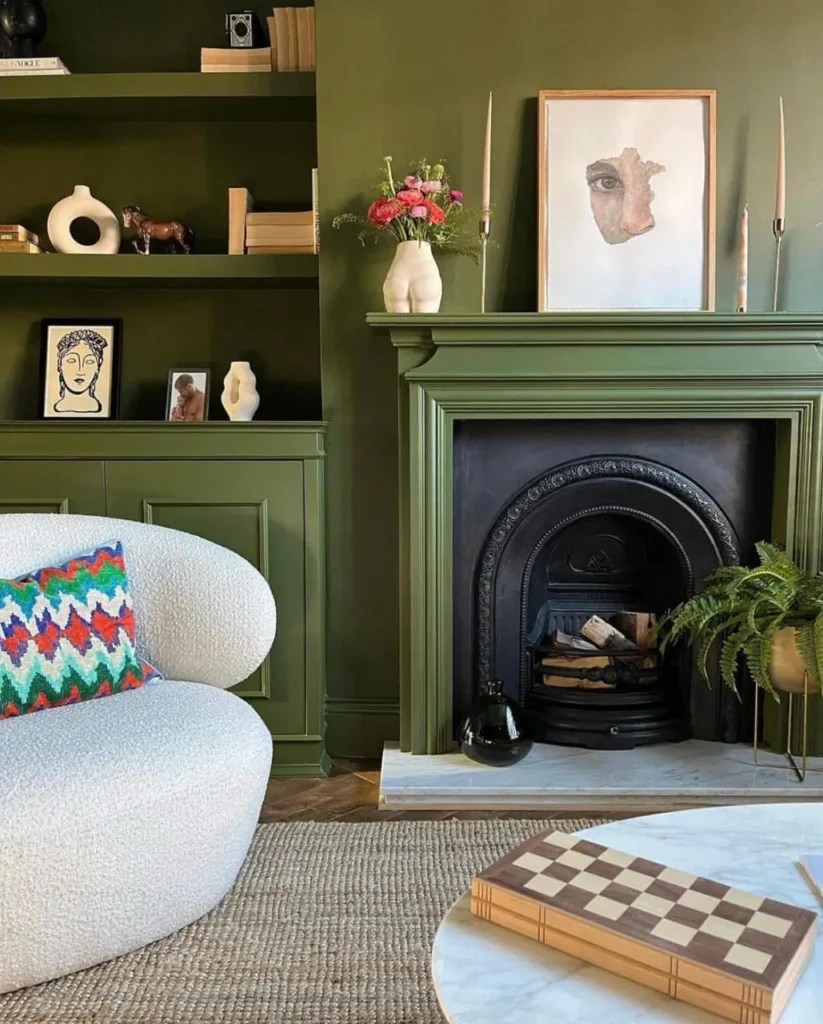
Image Credit: @gold_is_a_neutral
Why it works in living rooms:
Olive green brings a warm, inviting atmosphere without being too bold. It’s a great choice for both contemporary and traditional interiors, and it pairs easily with natural textures and earthy accents.
Styling tips:
- Pair with terracotta or ochre accents to emphasize its earthy warmth.
- Works well with wood furniture, particularly in walnut or oak tones.
- Layer linen cushions, soft throws, and woven rugs to create a cozy, textured space.
6. Invisible Green – Little Greene Paint Company
For a subtle, almost neutral green, Invisible Green is a brilliant pick. It’s soft, muted, and incredibly versatile, acting as a calming backdrop that lets your furniture, décor, and artwork shine.
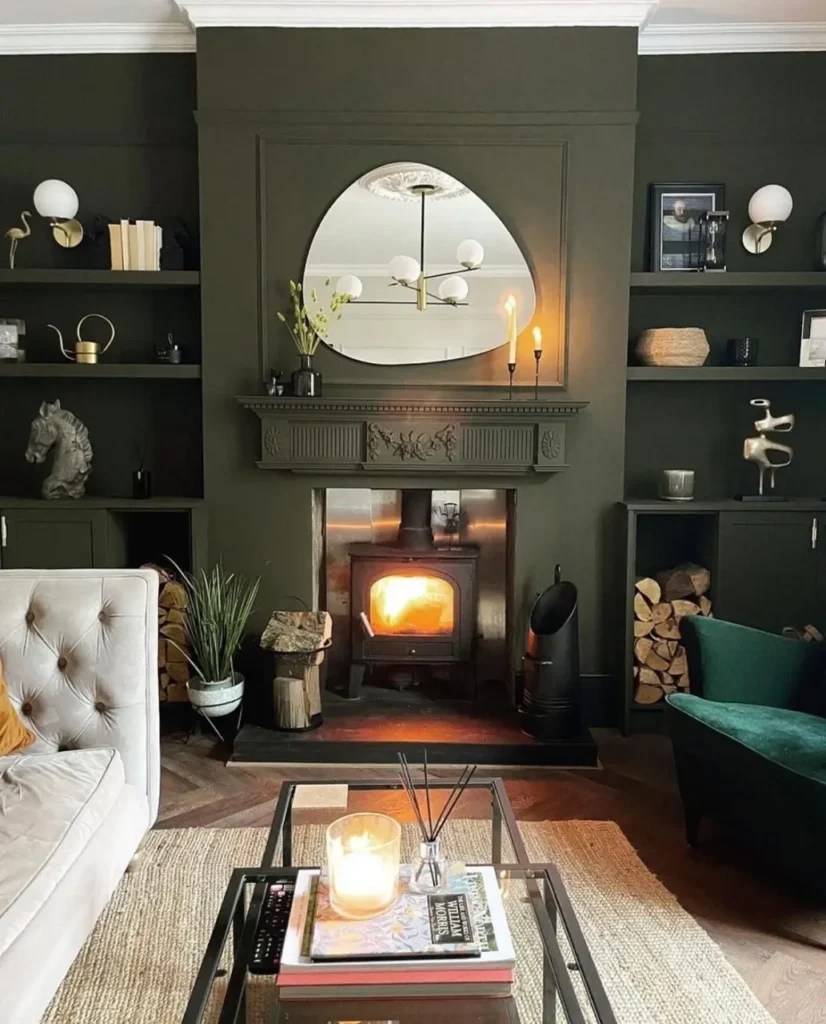
Design: @our.end.fourterrace
Why it works in living rooms:
Invisible Green is perfect if you want a minimalist or transitional look. It creates a serene environment, works in small spaces, and pairs beautifully with both warm and cool tones. It’s also a fantastic way to introduce green without committing to a bold statement color.
Styling tips:
- Pair with soft neutrals like cream, beige, or pale gray for a serene layered look.
- Add natural elements like wood, stone, or woven textures to give depth and warmth.
- Works beautifully with plants or green-themed décor to create a cohesive, nature-inspired space.
7. Pea Green – Little Greene Paint Company
For a bright, cheerful green that adds a playful touch without being overwhelming, Pea Green is a fantastic choice. It’s lively, mid-toned, and instantly gives a living room a fun, welcoming personality.
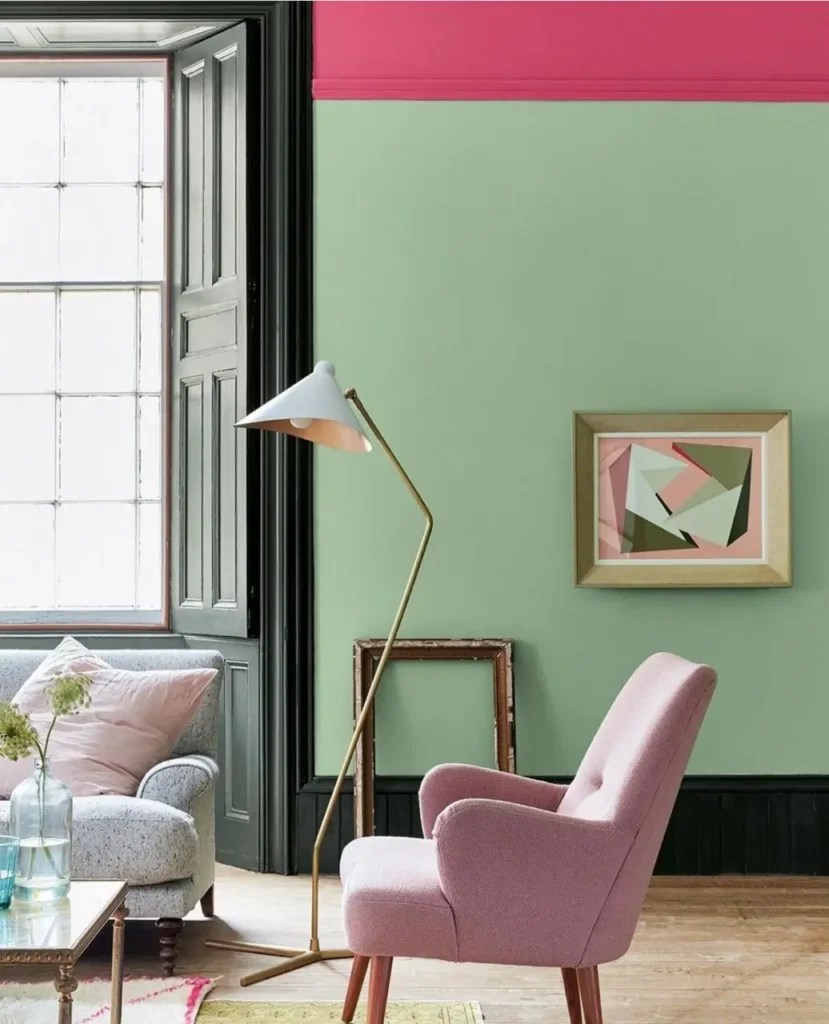
Image Credit: Littlegreene
Why it works in living rooms:
Pea Green is perfect for social or family spaces where you want energy and vibrancy. It’s bold enough to make an accent wall pop, yet versatile enough to work in a whole-room application if balanced with neutrals.
Styling tips:
- Pair with light wood or neutral furniture to keep the room feeling balanced.
- Introduce patterned cushions, rugs, or artwork for a playful, eclectic vibe.
- Add plants or botanical décor to echo the green and create a fresh, lively atmosphere.
8. Verde Marron – Sherwin Williams
For a deep, earthy green-brown, Verde Marron brings sophistication and a grounding presence to a living room. It’s a moody shade that works beautifully in cozy, intimate spaces.

Image Credit: Sherwin Williams
Why it works in living rooms:
Verde Marron is ideal for creating a cocooning effect—perfect for living rooms where you want warmth and depth. Its earthy undertones pair seamlessly with wood, leather, and warm metallic accents.
Styling tips:
- Combine with dark wood furniture and leather upholstery for a classic, rich look.
- Use textured textiles like wool or velvet to soften the depth.
- Accent with warm metallics like bronze or gold for subtle glamour
9. Baffin Island 243 – Benjamin Moore
If you’re looking for a cool, muted green with subtle gray undertones, Baffin Island 243 is an excellent choice. It’s understated, modern, and brings a sense of calm and serenity to your living room.
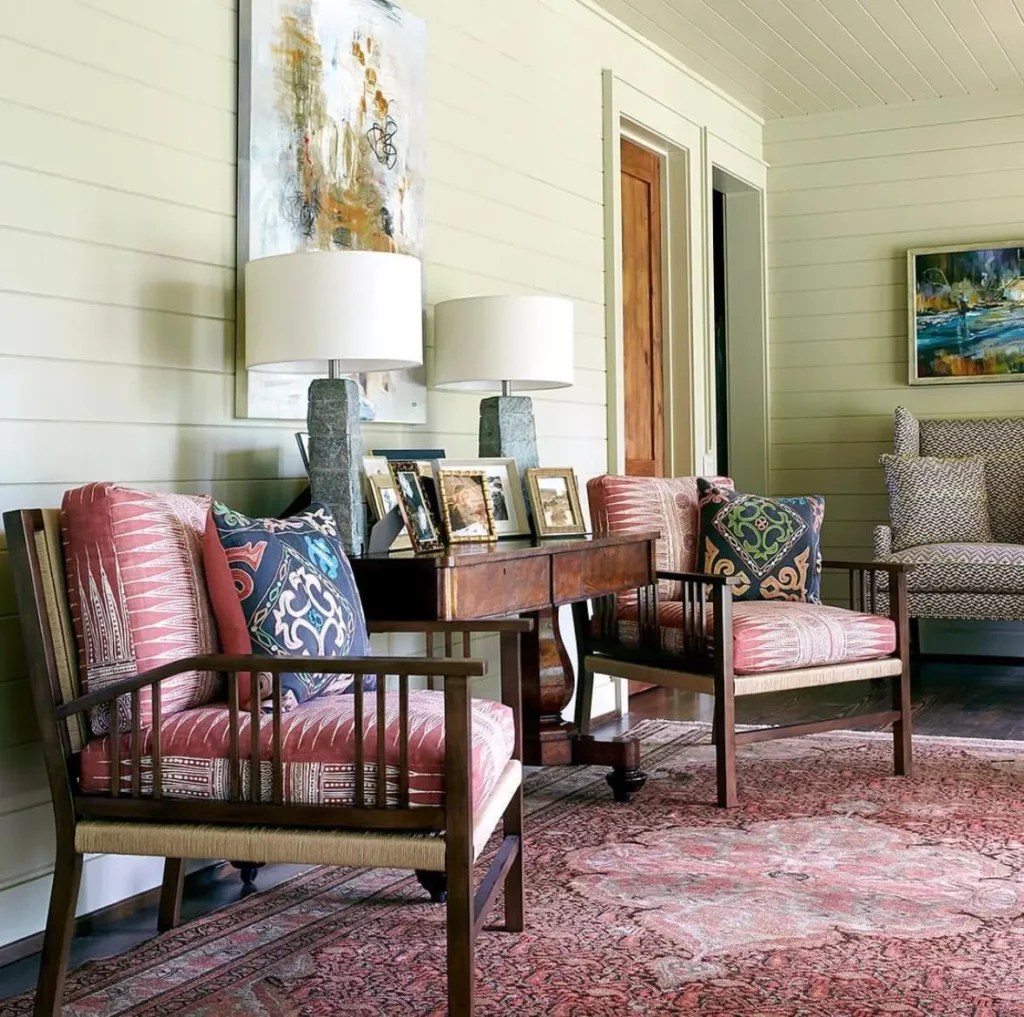
Design: maryevelyn 📷 davidhillegas
Why it works in living rooms:
Baffin Island 243 is perfect for creating a contemporary, peaceful environment. Its muted tone makes it versatile enough to cover all walls or act as a backdrop for bolder accents. It pairs well with minimalist or Scandinavian-inspired interiors.
Styling tips:
- Pair with light neutrals like cream or soft gray to enhance its calming effect.
- Add natural wood furniture and textures to prevent the space from feeling cold.
- Accent with soft metallics or muted color pops in cushions, artwork, or décor for subtle visual interest.
10. Fairmont Green HC-127 – Benjamin Moore
For a classic, timeless green, Fairmont Green HC-127 is a sophisticated choice. It’s rich yet approachable, making it perfect for living rooms that aim for elegance and versatility.
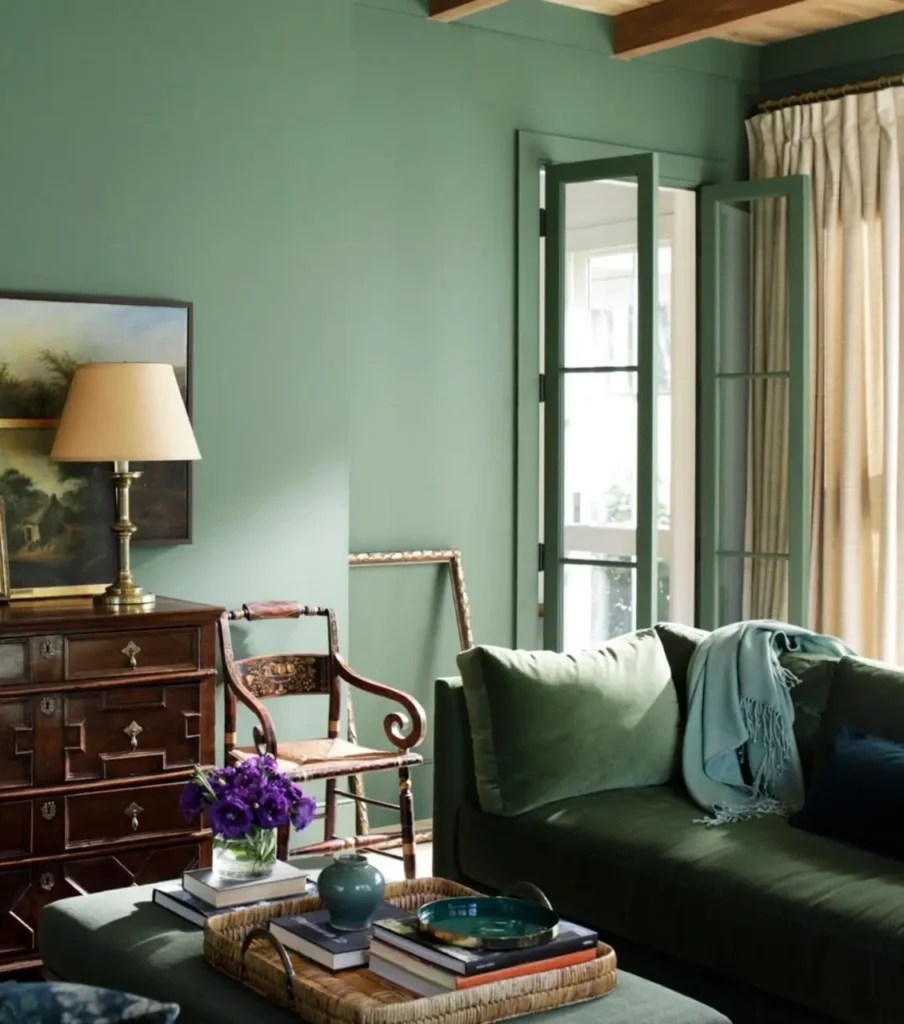
Image Credit: Benjamin Moore
Why it works in living rooms:
Fairmont Green adds depth and warmth without being overpowering. It’s suitable for traditional, transitional, or even modern interiors, giving the space a welcoming, refined feel.
Styling tips:
- Pair with antique or classic furniture for a timeless look.
- Layer with textured fabrics like velvet, linen, or wool for warmth and dimension.
- Use warm metallic accents such as brass or gold to highlight the green’s richness.
Wrapping Up Part 2
And just like that, we’ve reached the end of Part 2 of our green living room series! With these additional shades, you now have a full palette of greens to explore—I hope this post has given you the inspiration and encouragement to explore green for your living room. Even if you’re still experimenting with shades, the goal is to help you imagine a space that reflects your style and taste.
If you haven’t explored Part 1 yet, check it out here—it covers the first 10 shades and completes the full 20-color roundup. Together, both posts give you a comprehensive look at how versatile and grounding green can be in a living room.
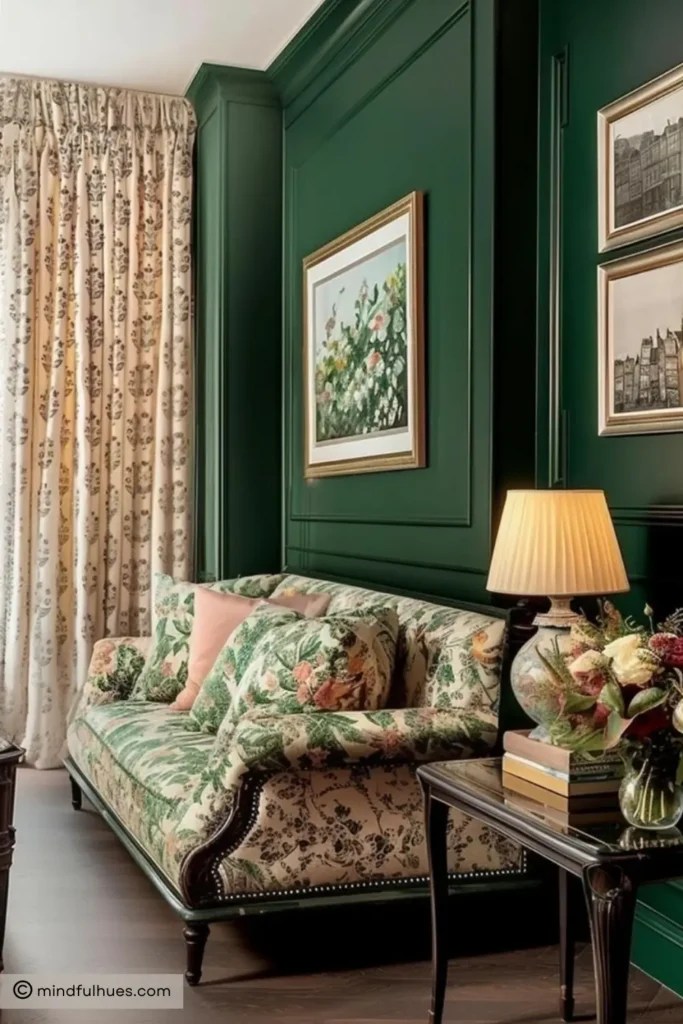
Not sure if green is the right fit for your vibe? You might also enjoy other color directions: if you’re seeking a soothing, serene atmosphere, my post on blue living room paint colors is full of ideas for calm, relaxing spaces. On the other hand, if you want a bright, versatile canvas that lets your furniture, artwork, and décor truly shine, my white living room paint colors post is packed with inspiration for crisp, airy spaces.
And for anyone wondering about Farrow & Ball greens—don’t worry! Their palette is so beautiful and expansive that it deserves a post of its own. I’ll be sharing a dedicated roundup of 15 Farrow & Ball Green Living Room Paint Colors soon, so you’ll have even more options to explore.
No matter your style—muted, moody, or bold—this series is designed to help you find the green that makes your living room feel welcoming, stylish, and totally you. After all, picking the right green isn’t just about paint—it’s about creating a space you’ll love to come home to.
Leave a Reply